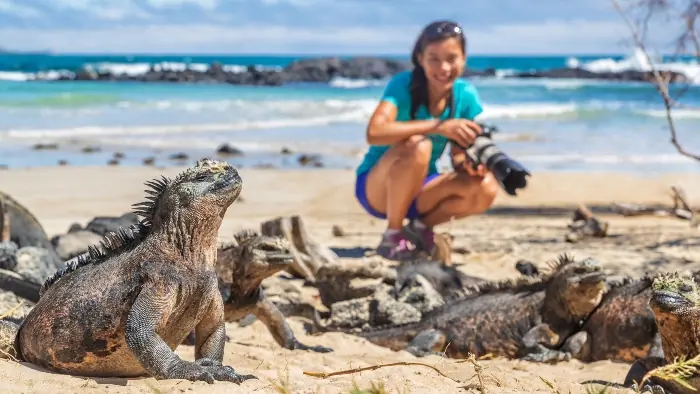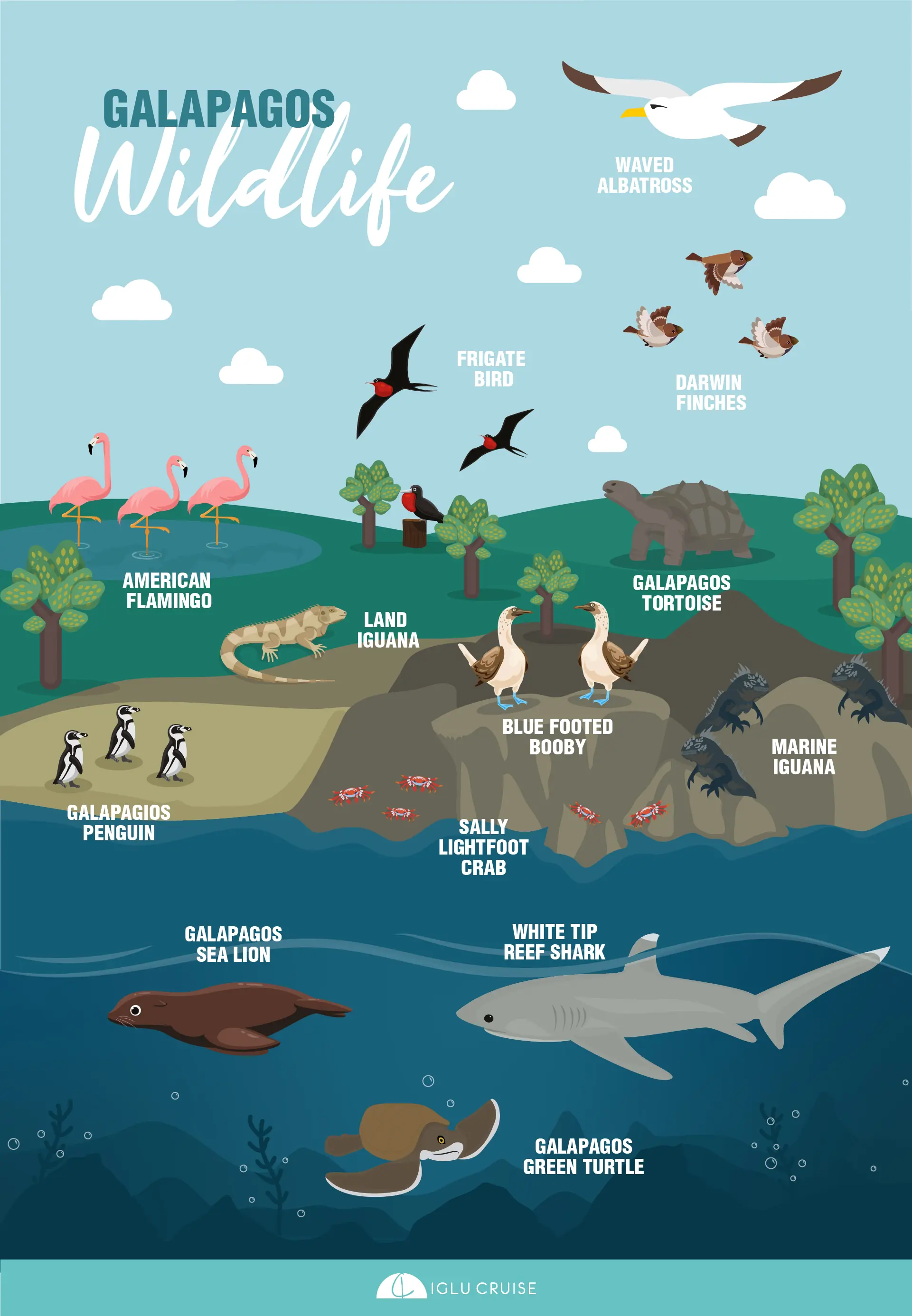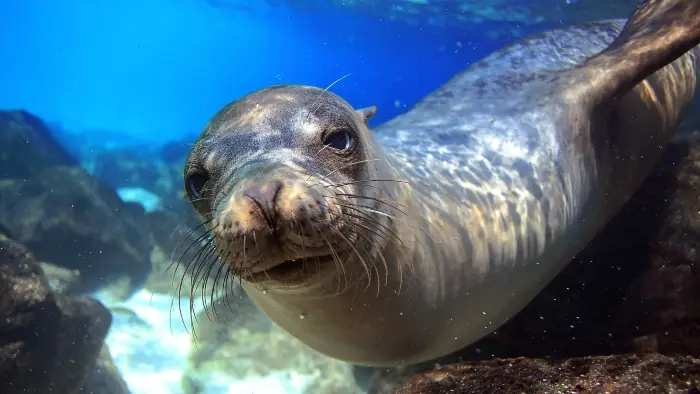Galapagos Cruise Tips

Galapagos cruises are typically ‘expedition cruises’. There’s less of a focus on relaxation and lounging, and schedules are tightly packed with excursions that will immerse you in the islands. However, that’s not to say you won’t find luxury in this stunning part of the world. Cruise lines go above and beyond to provide the utmost comfort onboard with some, such as Celebrity Cruises and Silversea, offering world-class service and cuisine.
Located more than 600 miles off the coast of Ecuador, the 21 islands that comprise the Galapagos are home to far more species than you might realise. The famous biologist Charles Darwin visited in 1835, and it is said that the discoveries he made here went on to inspire his theory of evolution. This is because many of the species found here cannot be found anywhere else, meaning they have developed in accordance with what the region can supply - which is indicative of the process of natural selection.

Top tips for the best Galapagos Islands holiday
A Galapagos cruise holiday is incredibly different to any other! While you’ll still have time to relax onboard in the sun, putting your feet up will not be the focus. Below are our top tips to keep in mind to get the most out of your holiday.
1. Pack sensibly
Perhaps the most vital of all, packing sensible, suitable clothing will ensure you are able to partake in all activities safely and comfortably. Leave the formal shoes at home- you won’t need a pair of heels here! The terrain is uneven and with numerous hikes being part of the itinerary, sturdy footwear is essential.
We highly recommend packing the below:
- Quick-dry/waterproof clothing - When it rains in the Galapagos, it pours! A lightweight waterproof jacket is a must.
- Waterproof daypack - Carrying all your necessities will be a lot more comfortable in a good daypack.
- Sun hat - The equatorial sun is incredibly harsh. Keep yourself protected at all times with a suitable wide-brim hat.
- Shorts - Some excursions will require wet-landings, meaning you’ll be in knee-deep water. A pair of shorts will allow you to dry off in no time.
- Sun-block - As mentioned, the sun is harsh in this part of the world- we are on the equator! Keep water-resistant sunblock in your bag at all times.
- Hiking boots/sandals - A pair of tough shoes are imperative for excursions.
- Bug spray - Although they are generally not a huge issue, there are wasps and other flies in the Galapagos.
2. Prepare for sea-sickness
Although not all of us are affected by sea-sickness, the Humboldt Current can arrive with choppy waves that could make you feel nauseous. Many ships supply sea-sickness relief onboard, but bringing your own in your luggage is a great back-up.
3. Do your research
A Galapagos cruise holiday is by far one of the most historically and culturally enriching voyages you will embark upon. There are new destinations to discover every day, meaning you’ll come across wildlife you won’t see anywhere else, otherworldly flora and fauna and landscapes that have been carved for hundreds of years. As a result, it’s best to do some research beforehand, such as the best time for a Galapagos cruise, or attend the insightful lectures onboard with local guides and expert naturalists. These will give you a great run down on the island you are going to visit, as well as safety tips.
4. Invest in a good camera
There is simply so much to do in the Galapagos that it’ll be tricky to remember all your favourite moments. We highly recommend investing in a good waterproof camera such as a GoPro, allowing you to record playful seals as they zip around you underwater.
It’s also a great idea to invest in a sturdy zoom lens. Although you’ll find that the wildlife is very tolerant of guests, it’s best to keep your distance to avoid disturbing the residents. A zoom lens will allow you to get excellent quality images without intruding - and be sure to remember the spare batteries and memory cards!
5. Prepare for exercise
The excursions on your Galapagos cruise holiday are physically demanding. Expect to be on the Zodiac bright and early in the morning and disembarking by wet-landing (passengers are often required to hop into knee-deep water to get ashore). A typical hike can be up to two hours in duration, though if one of the group is unable to keep up, everyone must turn back.
In order to help you - and your fellow passengers - get the most out of your Galapagos cruise, you must keep in mind any mobility difficulties may affect your experience. If you feel that a particular activity may be too much, you can opt to stay onboard and enjoy the breath-taking views from on deck.
6. Enjoy a hearty breakfast
Due to the early mornings, the ship’s crew provide a plentiful breakfast before you embark on your first excursion of the day. Food is not allowed on the islands in order to protect the ecosystem, so be sure to fill up on a good meal before you leave!
Galapagos Wildlife
The wildlife of this archipelago is one of the biggest reasons so many visitors flock each year. Numerous species are endemic to the islands, making them a truly unique sight that you won’t find anywhere else. Onboard your cruise, enriching lectures will provide you with fantastic insights into each species, but for a quick run-down, check out the list below.

Blue-footed Boobies
Average wingspan: 1.5 metres
Lifespan: 17 years
Where to see them: Mainly North Seymour Island as well as Espanola, Fernandina, Floreana, Isabela, Pinzon, and Santa Cruz islands
When to see them: Breeding season between June and August
Named after their clumsy walk on land, Blue-footed Boobies are one of the most distinctive birds of the Galapagos. The vivid colour of their feet plays a key role in courting while their streamlined shape allows them to dive into the water when hunting.
Galapagos Giant Tortoise
Average size: 1.5 metres
Lifespan: 100+ years
Where to see them: Santa Cruz, Isabela, San Cristobal, Santiago and Espanola islands
When to see them: Year round
One of the most famous animals on the island, the Galapagos was actually named after these gentle giants. The Galapagos Giant Tortoise spends around 16 hours per day resting, while the rest of the time is spent foraging for grass and fruit. These ancient creatures can live for over a hundred years.
Marine Iguana
Average size: 0.7 metres
Lifespan: 5-12 years
Where to see them: Coasts of Isabela, Fernandina, Española, Floreana and Santa Cruz islands
When to see them: Year round
The only lizard in the world that can live and forage at sea, the Marine Iguana has six subspecies that thrive across the islands. While they may seem very lazy on land as they group together to bask in the sun, they are expertly agile swimmers and fascinating to watch as they feed beneath the surface.
Land Iguana
Average size: 1 metre
Lifespan: 55 years
Where to see them: Fernandina, Isabela, Santa Cruz, South Plaza, Baltra, Santiago and North Seymour islands
When to see them: Year round
These vibrant yellow lizards are certainly hard to miss. Despite their flashy and intimidating appearance, they are primarily herbivores and quite docile. You may even spot Darwin’s Finches perched on their backs, picking insects from their skin!
Galapagos Sea Lion
Average size: 2 metres
Lifespan: 15-20 years
Where to see them: Coasts of all Galapagos islands
When to see them: Year round
Perhaps one of the most enjoyable species to watch in the archipelago, Galapagos Sea Lions are incredibly inquisitive and playful residents. You’ll easily spot them lazing in the sun on the beach, on rocks or even in town, as well as hunting in the ocean for sardines.
Galapagos Green Turtles
Average size: 84 centimetres
Lifespan: 80 years
Where to see them: Coastal waters of the region
When to see them: Year round
Galapagos Green Turtles overcome many hardships in order to mature to grown adults. As hatchlings they are incredibly vulnerable to numerous predators onshore and in the sea, but as adults they can reach speeds of up to 35km per hour. You can spot them foraging for food beneath the surface, or even taking a nap!
Whitetip Reef Shark
Average size: 1.5 metres
Lifespan: 14-19 years
Where to see them: Coasts of all the islands, especially North Seymour Island
When to see them: Year round
One of the most commonly sighted sharks in the Galapagos, Whitetip Reef Sharks prefer shallow water. During the day they crowd around caves and crevices in large groups, before hunting smaller fish amongst the coral. They are docile creatures and, although not fans of intruders, they are not aggressive.
Frigatebird
Average size: 2.15 metres
Lifespan: 15-25 years
Where to see them: Colonies are found on North Seymour, Floreana, San Cristobal and Genovesa islands
When to see them: Year round
The unique Frigatebirds are known as ‘pirate birds’ for their habit of stealing from their neighbours. With an incredibly large wingspan and a large red throat pouch they’ll be hard to miss whether you’re admiring the view from on deck or ashore on a hike. Keep an eye out for their nests in shrubbery too.
Galapagos Penguins
Average size: 49 centimetres
Lifespan: 20 years
Where to see them: Isabela, Fernandina, Floreana and Santiago islands
When to see them: Year round
One of the smallest penguins in the world, the Galapagos Penguins are incredibly agile in the water and can reach speeds of up to 35km per hour. You’ll spot them basking on the rocks on land as well as hiding in caves and crevices.The current population consists of just over 2,000 birds, making them more difficult to spot than others.
Waved Albatross
Average wingspan: 2.2 metres
Lifespan: 30 years
Where to see them: Mainly Espanola Island, but can be found throughout the region
When to see them: Any time of year apart from January to March
The largest bird in the Galapagos, the Waved Albatross are expert gliders and spend the majority of their lives soaring over the ocean. During mating season you’ll also spot them doing a fascinating courtship dance, a very complex ritual leading to couples that mate for life.
Sally Lightfoot Crabs
Average size: 5 centimetres
Lifespan: Unknown
Where to see them: Beaches and shallow water on all islands
When to see them: Daytime, year round
These scavengers are small but mighty and are an integral part of the Galapagos ecosystem. Feeding on just about anything, they keep the shores clean and can even be spotted picking insects from the iguanas. Though their vibrant colour makes them easy to spot, they are extremely agile and very difficult to catch.
American Flamingo
Average size: 1.2-1.45 metres tall
Lifespan: 60 years
Where to see them: Floreana and Isabela islands’ lagoons
When to see them: March to July
Like all other types of flamingo, the American Flamingo is bright pink from their diet of algae, crustaceans and plants. They are typically much smaller than other flamingo and, due to their small population, are harder to find than other birds in the Galapagos despite their colourful plumage.
Darwin’s Finches
Average size: -
Lifespan: -
Where to see them: Different breeds can be found on different islands.
When to see them: March to July
Named after Charles Darwin, there are currently 13 types that are natives of the islands. Each have evolved unique features, such as a wide variety of beak sizes and shapes that allow them to thrive in their diverse habitats, However they are otherwise all similar in appearance until you get a closer look.

Whether you’re looking to cross another destination off of your bucket list or are simply in need of a holiday that’s a bit different to the usual, a Galapagos cruise will broaden your horizons like no other. If you’re a solo cruiser, this is the perfect intimate experience to meet other like-minded travellers, while if you’re cruising with your family the kids will remember this experience forever, as will you and your partner if you embark on a honeymoon cruise to the Galapagos Islands. The cost of a Galapagos holiday may be more than a typical cruise holiday but we guarantee that the memories will be worth it! Now you've read our Galapagos cruise tips, find your perfect voyage with our guide to the best Galapagos cruise itineraries.
See our selection of Luxury Cruises to the Galapagos Islands here.